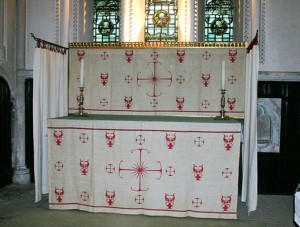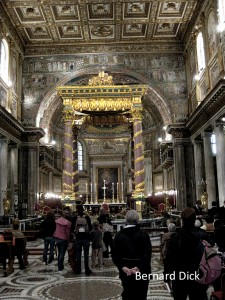The earliest –and longest running- thematic program in church construction and decoration is the vision of the “Heavenly Jerusalem” as described in the Book of Revelation.1 Church buildings have most often been understood as symbolizing the biblical idea of a “walled city” where God dwelt in the Temple.
Without fail the earliest Christian basilicas were arranged longitudinally creating a sense of linear movement from the main entrance to the apse at the far end.2 There in the apse,3 in an image straight out of the Book of Revelation, we often find Christ enthroned, approached by processions of saints and sheep representing the faithful of the Church. The backgrounds to these images often consisted of shimmering gold mosaic tesserae. These basilica churches were sometimes referred to as “houses of mystery” by the pagans for the exterior of the churches were usually plain brick affairs while the interiors were filled with glowing images of Christ, angels and saints rendered in brilliantly colorful mosaics suggestive of a heavenly, transfigured state.

Western churches should be constructed according to a linear and hierarchical plan. To be biblical it should convey a sense of an absolute end. As such the fundamental organizing principle is processional; the church is moving towards its Lord. The Church is on a journey to be sure but it is not wandering aimlessly or going around in circles it is moving like an arrow to its heavenly goal. We are in the walled city (the building) and we are moving toward the Temple (the Lord).

Oftentimes, the entry doors to churches announce to visitors that they are about to enter heaven. In the medieval period it was also made clear by the “Last Judgment” scene over the entrance that one had better prepare for when they would actually stand before the gates and seek admittance.
Church buildings through subsequent centuries continued the theme of the “walled city” in various ways. And, while the new Temple within the walled city was understood to be Jesus and the people of God gathered to Him, the arrangement of the church’s interior space and the church’s furnishings recalled the earthly Temple. Some spaces, as in the Jerusalem Temple, were more sacred than others, and were reserved for the clergy. The mystery suggested by the curtain of the old Temple was carried over into the Christian churches by the use of hung drapery or of veiling in various ways or circumstances.

Riddle curtains evoke biblical connotations and liturgically separate the altar from the rest of the church, suggesting its sacredness and mystery. Vesting the altar recalls the high priests vestments and reminds us that Christ, symbolized by the altar, is our High Priest. Picture Source
Even the clothing worn by the Christian clergy eventually was understood in reference to the vestments of the Temple priests. Roman street clothing which was originally worn by the Christian clergy took on spiritual meanings as Roman styles of daily dress fell out of popular style but were maintained by the clergy.4 Even so, in the third century, before the appearance of distinctive priestly vestments, Christian writers compared the clergy to the priests of the old Jerusalem Temple.

Ciboria and baldachins symbolize the Holy of Holies in the Jerusalem Temple. The baldachin and the entire church are often profusely decorated in colorful imagery and rendered in precious metals or materials in order to simulate a heavenly city, a city beyond our imagination.

In the Book of Revelation we read of saints and angels around the Throne of God. The Church has often incarnated this vision in stone and paint surrounding the earthly altar with such images. Tabernacles, of course, are obvious references to the Holy of Holies and the special presence of the Lord.
There are other decorative and symbolic themes in our Catholic tradition but the “Heavenly City” is fundamental. The others are related to it. Rich in meaning and reflective of our Jewish and biblical heritage, what a shame it is that we have jettisoned it in so many of our contemporary churches. But, it doesn’t take much to begin a recovery of the tradition. I’ve watched the Fellowship of Saint Alban, a very small congregation without anything material in stock, gradually and simply construct a vision of the “Heavenly Jerusalem” over the last few months.

(Fellowship of Saint Alban) The riddle curtains and vested altar and candle holders are set-up before, and taken down after, each Fellowship Mass in a church generously donated to the congregation for use on Sundays.
____________________________
1 I will introduce the other themes in subsequent posts. The Eastern Churches developed a significantly different architectural and thematic program around the 6th century.
2 The fundamental organizing principal of early Christian church architecture and decoration is processional; a movement through time and space from an absolute beginning to an absolute end.
3 The arrangement varies. Sometimes the eschatological theme is also carried onto the triumphal arch that separated the nave from the more sacred part of the church in some churches.
4 Barbarian dress eventually supplanted Roman styles.
Tags: Chancel Images, Church Architecture, Liturgical art, Liturgy, Orthodoxy at Work
|
